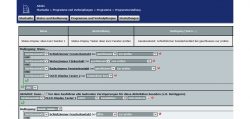
In the new programming guide we show today at Funkyhome.de especially beginners how to create programs for the Homematic color display to show for example the status of windows and shutters. In doing so, we will use the program to let the push-buttons query the values with a short press and with a long press we will let all shutters in the house move up or down or move the shutters to a certain position as sun protection.
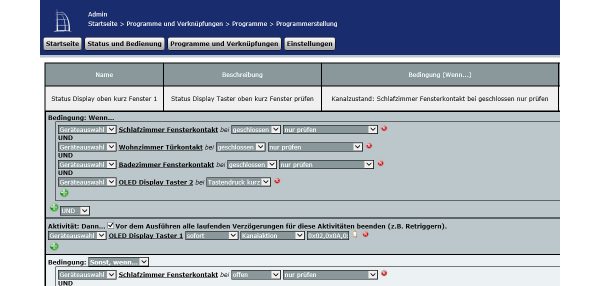
OLED Status Display Create programs …
Programs can be used to solve complex tasks in the Homematic CCU2 control unit and to combine several actuators comfortably. The CCU2 control unit does not even require any programming knowledge, as the desired tasks are simply selected using the graphic interface.
In our OLED status display example, we create a program that allows you to easily recognize open windows or doors at the push of a button and see whether all shutters or awnings are extended or retracted. In addition, with a longer keystroke upwards all roller shutters in the house are raised and with a longer keystroke downwards all roller shutters in the entire building are lowered.
Create Homematic system variable …
If you wish, you can create system variables for all possible states (such as “windows and doors closed”), which can then be conveniently queried. How this works exactly, we recently explained in the Homematic E-Paper Status Display Programming Guide.
Today, in contrast, we take the more direct way, without any system variable.
Show on display by a short keystroke whether windows and doors are closed …
For programming, select Programs and connections -> Programs -> New in the CCU2 user interface and enter a meaningful name such as “Status display top short window” and, if necessary, a description such as “Status display button top short window check”. After that you choose at the condition: If … as device selection select the desired window contact to be queried. Here you can first simply check all door/window contacts when closed and link them with AND. In addition, “Device selection” OLED display push-button 2 (yes, top is 2 and bottom is 1) can also be linked with AND when “Push-button short” is pressed. The best way is to use this as the first point and not at the end as in this example. During the activity: Then … select “device selection” -> an OLED display button channel (we had called it in the Homematic Status Display Tutorial OLED Display 3), select immediately, channel action.
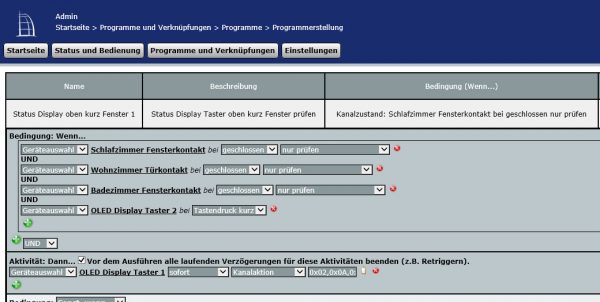
Now a small popup window opens, where you can output the previously stored text (see OLED Display Teaching Tutorial) or a free text with 12 characters and an icon in the desired colour. Line 1 and line 6 are left unused in this example. In the example we enter “All” as free text in line 2, “Window” in line 3, “Closed” in line 4 and not used in line 5, because we only want to display the icon “All OK”, i.e. a check mark. As colour we choose green. Those who have read the previous instruction will still remember the possibility to fix up to 20 texts. You should use this possibility to keep the Duty Cycle as low as possible. Since this is limited by law for the 868.3 MHz radio frequency, you run the risk of sending too many signals and then cannot send any more signals with the central unit for a certain period of time – that would be a disaster! In our example we send the free text for easy understanding.
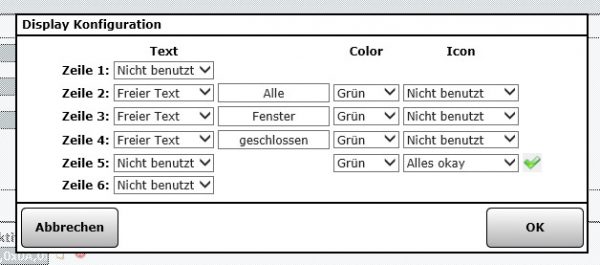
By the way, there are many more icons to choose from, so that you can assign a meaningful icon to the respective state.
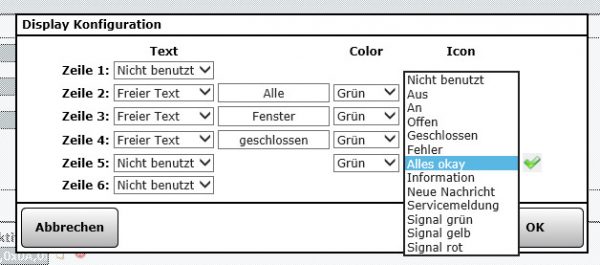
After clicking OK in the small popup window, you will be taken back to the page with the program. Now you could simply enter as condition: Otherwise … check all window contacts and door contacts with “open”. But we also want to check the status of every single window. We can do this by selecting Bedroom open, Living room closed, Bathroom closed, etc., and then pressing the button for the display button 2 and linking it with AND, …
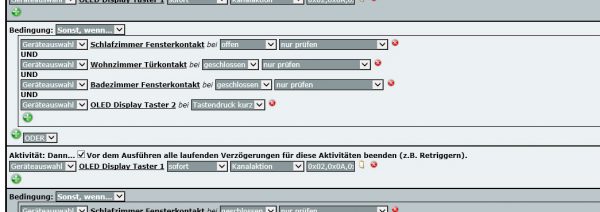
… to place the text “Bedroom open” or “Bedroom” in red colour with an error symbol in the popup.
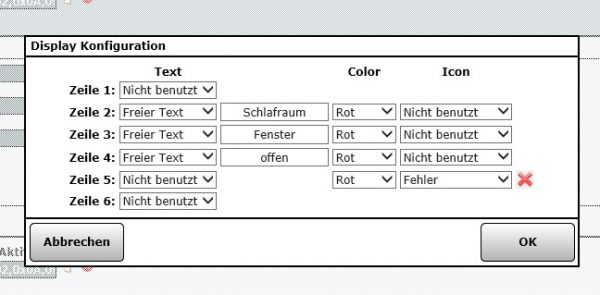
For example, the “Living room open” message on the Homematic colour display.
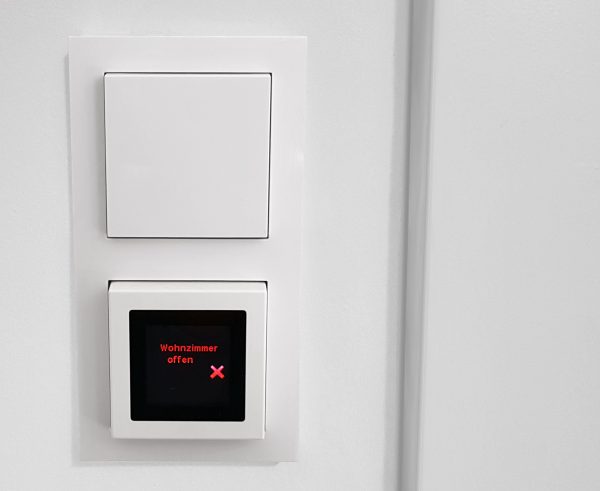
After you have done this for all window contacts, you create another Else if … instruction, where we again enter the display keystroke briefly and all window/door contacts. But this time with open OR linked! So if bedroom window open OR living room door open OR bathroom window open, etc. …
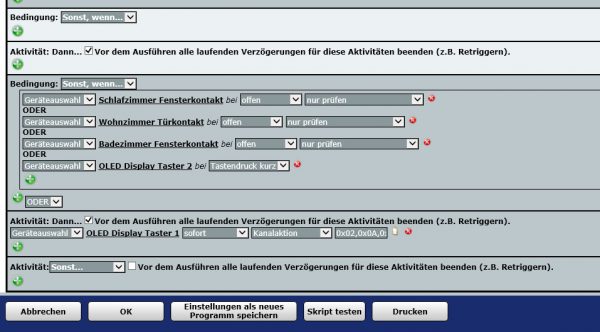
… When selecting a device, the popup “Several windows open” in red with an error symbol appears in the channel display.
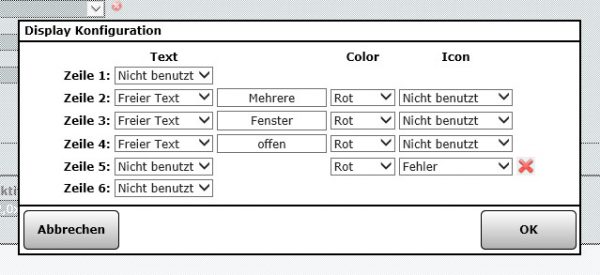
If you want, you can also go to the very end of the Or else … Activity to display a question mark symbol on the display to indicate that something is wrong. But we assume that no errors occur and leave it out, at least in this programming example.
However, even with this small programming you will notice that the effort is relatively large if you have many window contacts or door contacts. It becomes even more complex if you want to add more window contacts later on, because in the worst case you would really have to extend each program for each display with more AND links.
For this reason, we rather recommend the system variable for such tasks, because it can be easily queried and extended at any time with any program. Of course, there are many other states that can also be queried or triggered with the button. It is conceivable, for example, to query whether all lights in the house are switched off or whether all batteries of the Homematic devices are full enough or whether it is freezing outside and you should heat the pond or whether the sun is shining strongly to lower the shutters as sun protection or whether all shutters in the building have been raised or lowered. And the great thing about the system variable is that you don’t have to rebuild these queries in every program, but can access the system variables you created before. Another advantage is that system variables can also be retrieved conveniently via app! As already described in the Homematic CCU2 Test, you can query, operate and output the Homematic devices and system variables via third-party programs or apps such as TinyMatic. If you wish, you can also get a mail or a push message if the windows are open for more than half an hour, etc. … the possibilities are almost unlimited.
Press the button briefly to show on the display whether the roller shutters are down …
Exactly the same programming can now be created again for all shutters and output to the display by briefly pressing the button down.
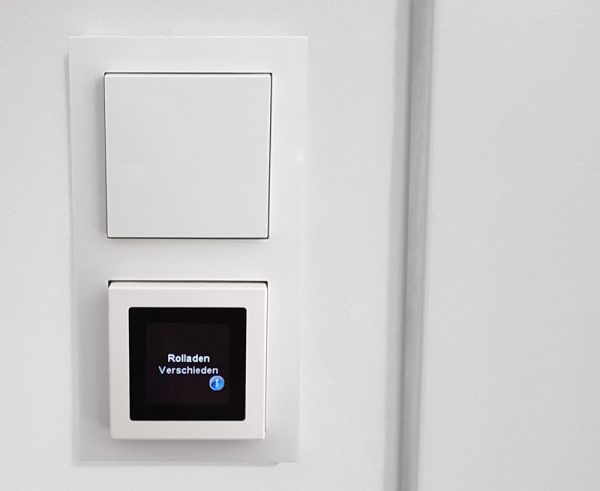
Output homematic variable via script on the status display …
It is a pity that it is not (yet?) possible to display system variables directly on the display, so the programs become correspondingly long if there are several window and door contacts. This is not a tragedy, since the performance of the CCU2 is completely sufficient for this purpose, but it is a lot of hard work and sometimes cumbersome to extend. For this reason, the OLED status display can alternatively be addressed via script. There are ready-made scripts, e.g. from DrTob, or you can program the response yourself. Unfortunately in both cases it is necessary to have or acquire at least basic programming knowledge. Hopefully, eQ-3 will soon be improved and allow for easier solutions, for example, via the graphical interface in Homematic CCU3. If you still want to control the display via script, we will be happy to help you in the Smarthome Forum.
A long key press downwards Roller shutter as sun protection …
In the following example, we lower all roller shutters to a desired height as sun protection in strong sunshine, which is simply entered at the curtain height. To do this, simply lower the roller shutter completely by hand and then set it to the desired height. Now request this percentage value of the height via the CCU2 control unit or via the app and then enter this value as a percentage for the respective roller shutter at the blind height. As the percentage values always vary slightly depending on the previous position of the roller shutter, in this example program we let the roller shutters first be completely lowered to 0% and then return to the desired sun protection height with a small delay of 40 or 45 seconds. This saves the calibration drive and allows you to control the same value from every blind height.
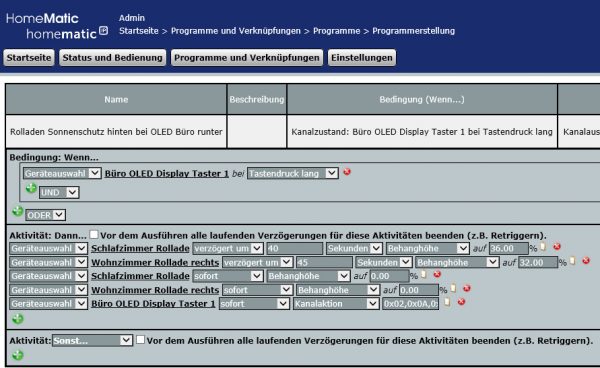
How to use roller shutters or awnings automatically as sun protection in strong sunshine, we will soon also explain in a separate Homematic Tutorial on Funkyhome.de after we have tested the temperature difference sensor.
Note on the Homematic programs …
Once again briefly to refresh from the Homematic Thermostat Programme Tutorial:
Programs without an “If” condition must be deactivated after creation, otherwise they will be executed unintentionally, e.g. when the central unit is restarted. Therefore check the box “operable and visible” to be able to see and operate them in a smartphone app!
The programs shown above for the status display via the “If” condition, however, you want to activate and basically need no operation. Whether you make these programs visible and operable is up to you. However, depending on the number of programs it can get confusing and it is recommended to only show the programs you really want to use.
Tip: If you want to sort the Homematic programs alphabetically, simply go to Status and Operation -> Programs in the CCU2 control unit and the programs will be sorted alphabetically the next time you view them.
This guide to the OLED Status Display programs will be expanded in the course of time, as there are of course many more possibilities.
We hope that this little guide will help you and if you have any questions we will of course help you in our Homematic Forum.
Homematic OLED Status Display Review …
Discuss in our forum and share experiences about the OLED Display Programming Guide …
Here you can buy the Homematic OLED Status Display as kit. *Ad
